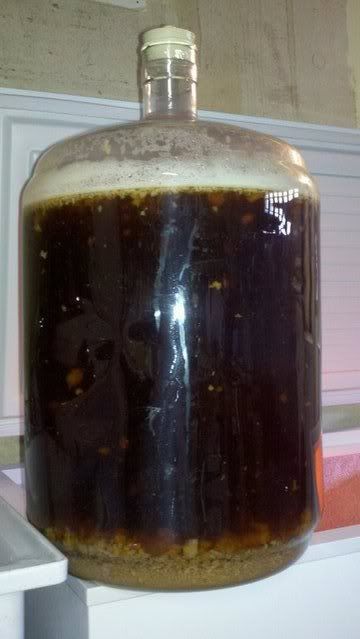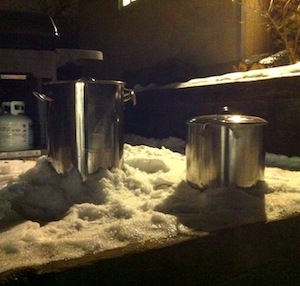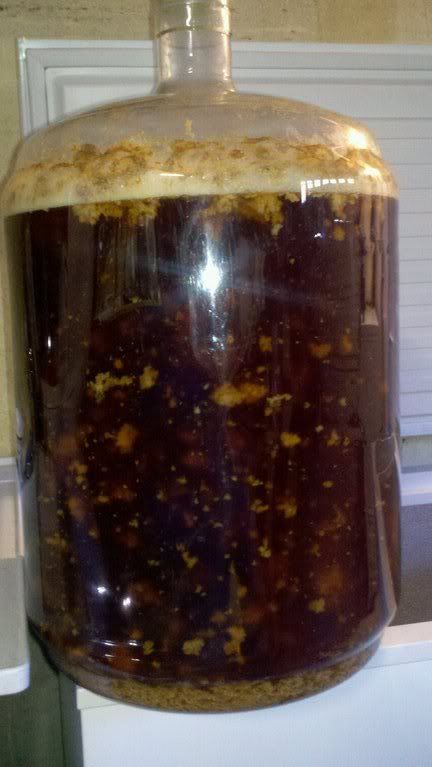I know, I know. And other then say that I was using a new plate chiller for the first time, and was distracted by the pride in remembering to use a "getter" magnet to retrieve the stir bar from my starter....I pitched into my fermentor THEN thought..crap...what's the wort temp?
Sure enough it was 100F.
The wort was in the carboy already, and I didn't want to compound my error by starting to run the wort+yeast through the chiller again, so I put the carboy in the fermentor/chest freezer, and taped the probe to the side of the carboy. The freezer kicked in, and within an hour the temp was in the 80s and at about 2 hours it was in the high 70s.
Now it's sitting (not showing signs of fermentation yet, but that's not abnormal, I brewed last night and pitched at about midnight) in the fermentor chamber at 66 degrees.
Info:
All Cascade IPA 75 minute boil
2 LBS DME with 30 minutes left in the boil.
7 LBS LME
Steeped 1lb of crystal 20L for 30 minutes at 150ish then yanked at 165ish.
Hopped at 75, 45, and 10min.
Cooled to 100 in about 10 minutes (should have gone slower..this was my mistake with the new wort chiller).
Pitched White Labs Cali Ale V.
OG: 1.066
So..speculation?
I'm not worried. I already did the RDWHAHB thing, I'm just at that point where waiting and thinking about my beer are the only options.
The only other time I pitched into high temps (2nd batch ever...I was told to just put my hand on the side of the kettle and when it was merely warm to go ahead and transfer/pitch), the bubbling started right away and I ended up with off-flavors from the high ferm temps...but this time it didn't get off to that rock and roll start, so I'm theorizing I shocked the yeast, and that when they do kick in I might be ok, but the lower attenuating V yeast may end me up a little on the short side for FG. I kind of figured out after I already had prepared my starter that Cali V may not be the best for an IPA.
Sure enough it was 100F.
The wort was in the carboy already, and I didn't want to compound my error by starting to run the wort+yeast through the chiller again, so I put the carboy in the fermentor/chest freezer, and taped the probe to the side of the carboy. The freezer kicked in, and within an hour the temp was in the 80s and at about 2 hours it was in the high 70s.
Now it's sitting (not showing signs of fermentation yet, but that's not abnormal, I brewed last night and pitched at about midnight) in the fermentor chamber at 66 degrees.
Info:
All Cascade IPA 75 minute boil
2 LBS DME with 30 minutes left in the boil.
7 LBS LME
Steeped 1lb of crystal 20L for 30 minutes at 150ish then yanked at 165ish.
Hopped at 75, 45, and 10min.
Cooled to 100 in about 10 minutes (should have gone slower..this was my mistake with the new wort chiller).
Pitched White Labs Cali Ale V.
OG: 1.066
So..speculation?
I'm not worried. I already did the RDWHAHB thing, I'm just at that point where waiting and thinking about my beer are the only options.
The only other time I pitched into high temps (2nd batch ever...I was told to just put my hand on the side of the kettle and when it was merely warm to go ahead and transfer/pitch), the bubbling started right away and I ended up with off-flavors from the high ferm temps...but this time it didn't get off to that rock and roll start, so I'm theorizing I shocked the yeast, and that when they do kick in I might be ok, but the lower attenuating V yeast may end me up a little on the short side for FG. I kind of figured out after I already had prepared my starter that Cali V may not be the best for an IPA.







